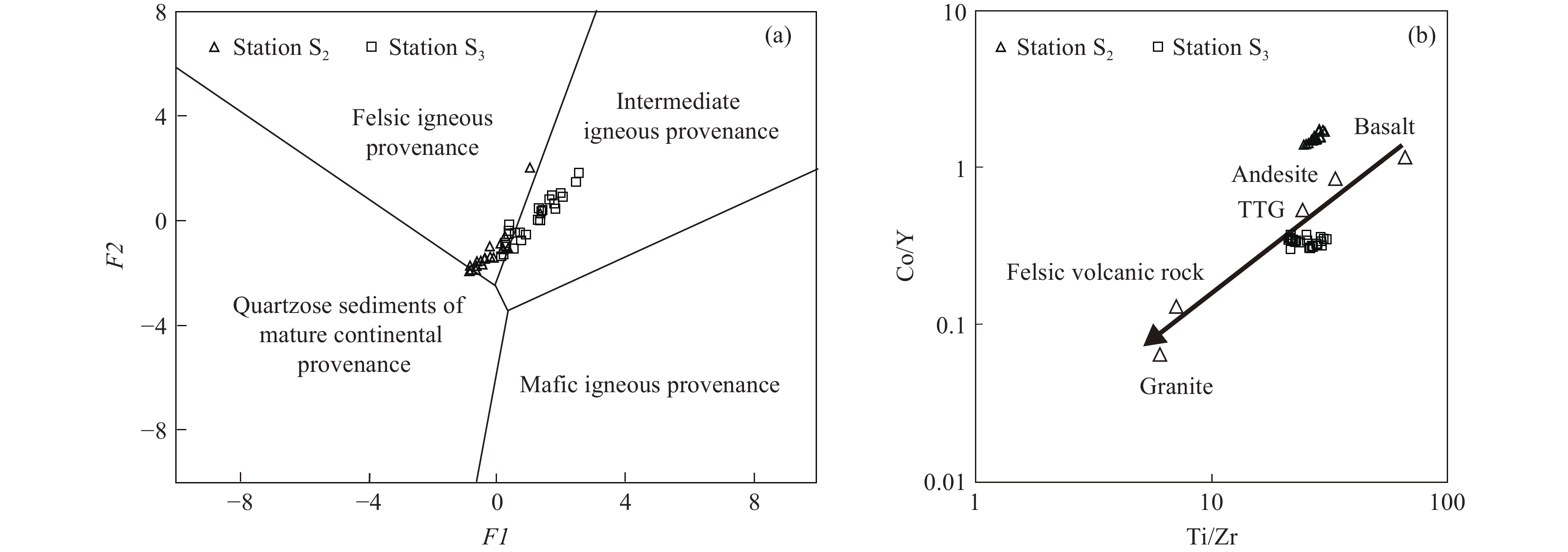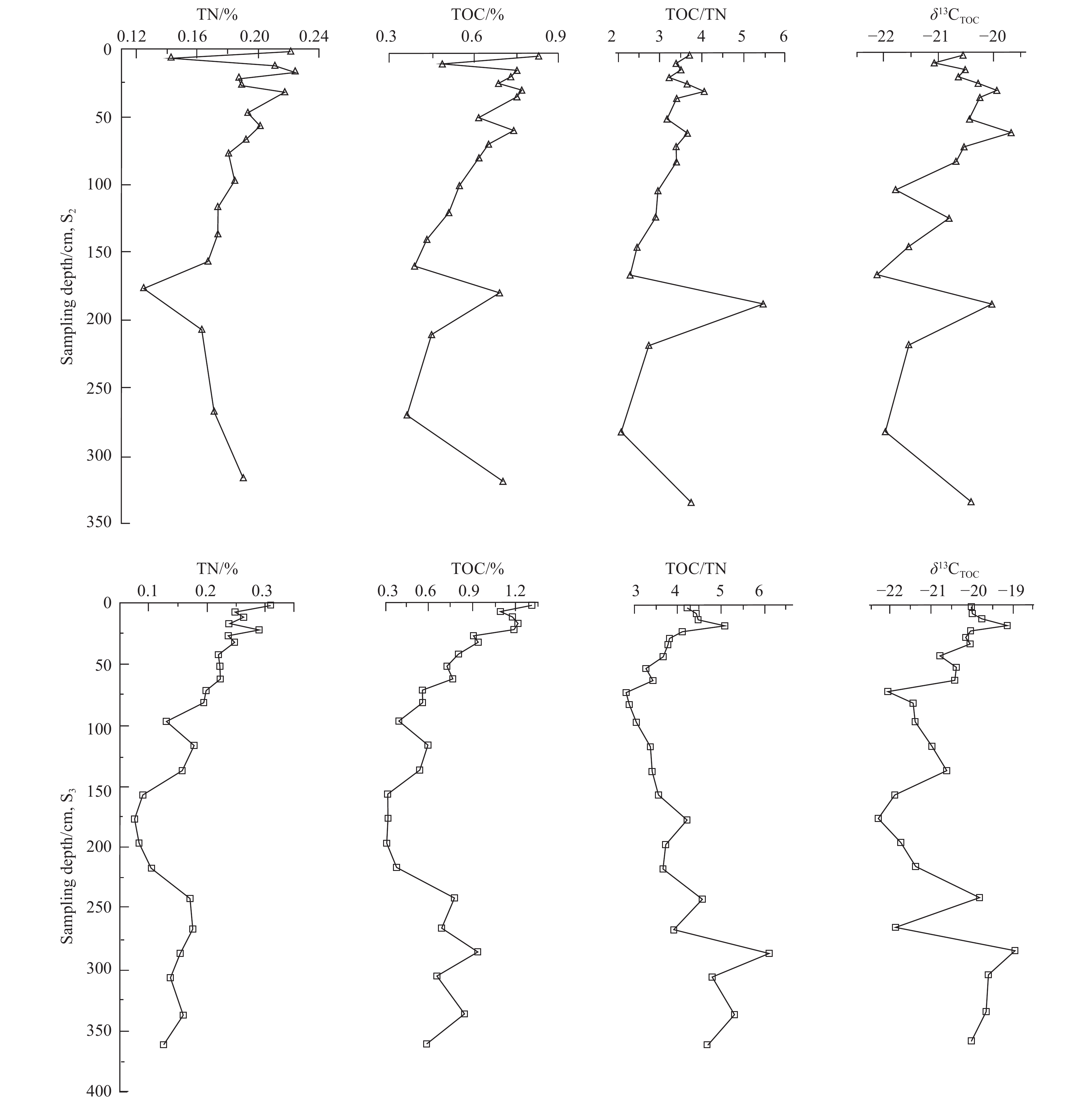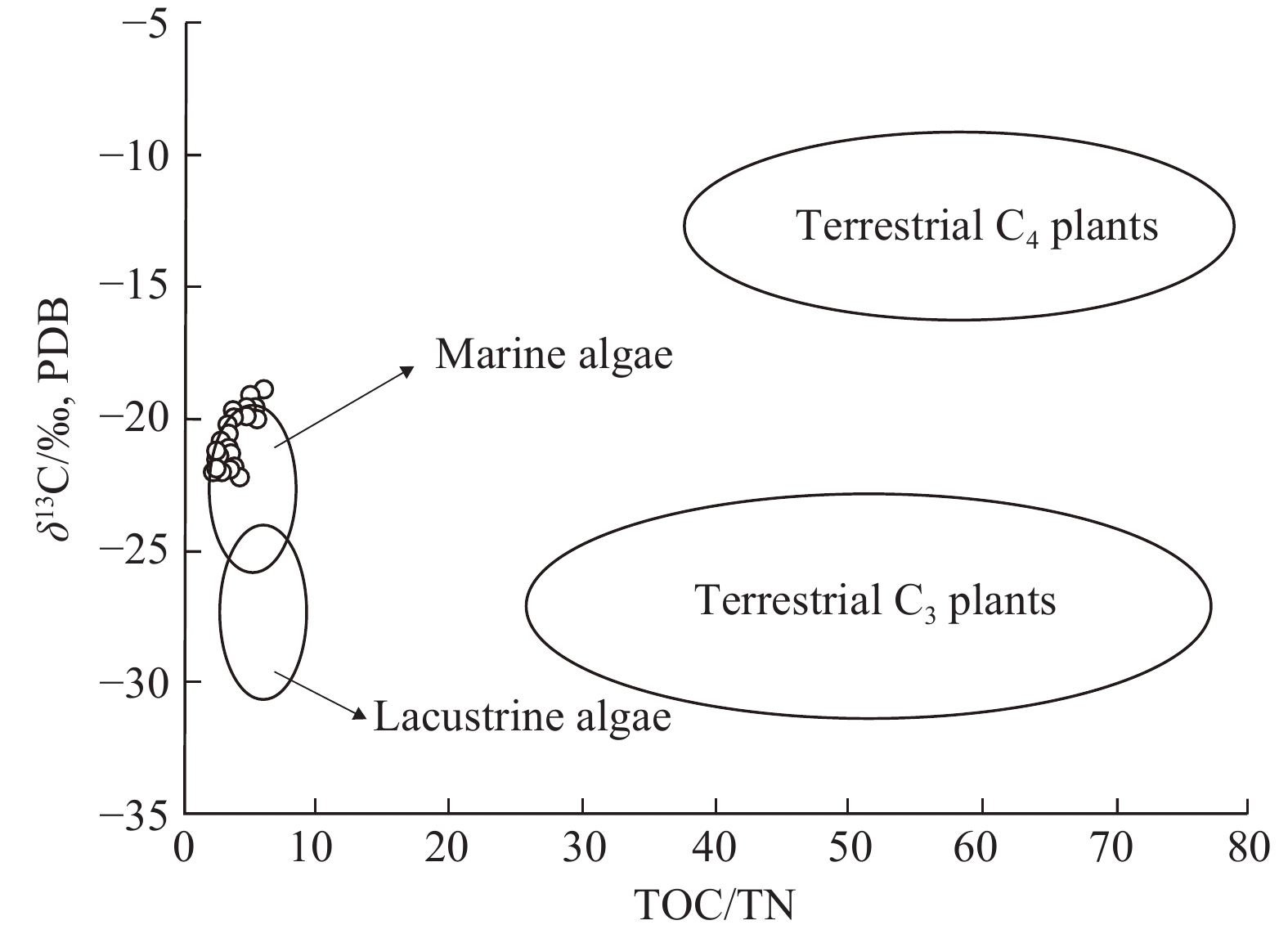| Citation: | Jian-ming Gong, Jing Liao, Yu-xi Zhang, Jie Liang, Jian-wen Chen, Nuzhat Khan, Syed Waseem Haider, 2021. Characteristics of major and trace elements in surface sediments of the Makran Accretionary Prism, Pakistan and their implications for natural gas hydrates, China Geology, 4, 299-310. doi: 10.31035/cg2021020 |
Characteristics of major and trace elements in surface sediments of the Makran Accretionary Prism, Pakistan and their implications for natural gas hydrates
-
Abstract
To accurately identify the natural gas hydrates (NGH) in the sea area of the Makran Accretionary Prism, Pakistan, this paper presents the testing and analysis of major and trace elements in sediment samples taken from two stations (S2 and S3) in the area by the China Geological Survey. As shown by testing results, all major elements are slightly different in content between the two stations except SiO2 and CaO. This also applies to the trace elements that include Sr and Ba primarily and Cr, Ni and Zn secondarily. It can be concluded in this study that the tectonic setting of the Makran Accretionary Prism is dominated by oceanic island arc and that provenance of the Makran Accretionary Prism is dominated by felsic igneous provenance, which is at the initial weathering stage and mainly consists of granodiorite. Besides terrigenous detritus, there are sediments possibly originating from Makran-Bela Ophiolite from the northwestern part and Murray Ridge igneous rocks from the southeastern part. The V/Cr, Ni/Co, and V/(V+Ni) ratios indicate that sediments of the two stations are in an oxidation-suboxidation environment. However, the authors infer that the sedimentary environment of the sediments 3.0 m below the seafloor tends to be gradually transformed into a reduction environment by comparison with the Qiongdongnan Basin in the South China Sea where NGH has been discovered. The sediments in the Makran Accretionary Prism are rich in organic matter, with total organic carbon (TOC) content greater than 1%. According to comprehensive research, the organic matter in the sediments mainly originates from marine algae and has high TOC content, which is favorable for the formation of NGH.
-

-
References
Algeo TJ, Rowe H. 2012. Paleoceanographic applications of trace-metal concentration data. Chemical Geology, 324−325, 6–18. doi: 10.1016/j.chemgeo.2011.09.002. Barbero E, Delavari M, Dolati A, Saccani E, Pandolfi L. 2020. The Ganj Complex reinterpreted as a Late Cretaceous volcanic arc: Implications for the geodynamic evolution of the North Makran domain (southeast Iran). Journal of Asian Earth Sciences, 195, 1–26. doi: 10.1016/j.jseaes.2020.104306. Burgath KP, Von Rad U, Van DLW, Block M, Khan AA, Roeser HA, Weiss W. 2002. Basalt and peridotite recovered from Murray Ridge: Are they of supra-subduction origin? Geological Society London Special Publications, 195(1), 117–135. doi: 10.1144/GSL.SP.2002.195.01.08. Cheng J, Wang SH, Huang Y, Yan W. 2019. Geochemical response characteristics of methane seepage activities in gas hydrate zones. Marine Sciences, 43(5), 110–122 (in Chinese with English abstract). doi: 10.11759/hykx20180426001. Deng XG, Fu SY, Huang YX, Zhang GX, Wu NY, Wu LS. 2006. Geochemical characteristics of sediments at Site HD196 in Dongsha Islands, the North of the South China Sea, and their implication for gas hydrates. Geoscience, 20(1), 92–102 (in Chinese with English abstract). Deng YN, Fang YX, Zhang X, Chen F, Wang HF, Ren JB, Liu CH, Guan Y. 2017. Trace element geochemistry of sediments in Qiongdongnan area, the South China Sea, and its implications for gas hydrates. Marine Geology & Quaternary Geology, 37(5), 70–81 (in Chinese with English abstract). doi: 10.16562/j.cnki.0256-1492.2017.05.007. Ghose NC, Chatterjee N, Fareeduddin. 2014. Pyroxenite. In: A Petrographic Atlas of Ophiolite, Chapter 11. New Delhi, Springer, 105‒106. doi: 10.1007/978-81-322-1569-1. Gong JM, Liao J, Liang J, Lei BH, Chen JW, Khalid M, HaiderSW, Meng M. 2020. Exploration of oil and gas prospects in the Northwestern part of the Offshore Indus Basin, Pakistan. China Geology, 3, 633–642. doi: 10.31035/cg2020051. Gong JM, Liao J, Sun J, Yang CS, Wang JQ, He YJ, Tian RC, Cheng QS, Chen ZQ. 2016. Factors controlling gas hydrate accumulation in Makran accretionary wedge off Pakistan. Marine Geology Frontiers, 32(12), 10–15 (in Chinese with English abstract). Gong JM, Liao J, Yin WH, Zhang L, He YJ, Sun ZL, Yang CS, Wang JQ, Huang W, Meng M, Cheng HY. 2018a. Gas hydrate accumulation models of Makran accretionary wedge, northern Indian Ocean. Marine Geology & Quaternary Geology, 38(2), 148–155 (in Chinese with English abstract). Gong JM, Liao J, Zhang L, He YJ, Zhai B, Meng M, Cheng HY. 2018b. Discussion on the distribution and main controlling factors of mud volcanoes in Makran Accretionary Wedge, Northern Indian Ocean. Geoscience, 32(5), 166–171 (in Chinese with English abstract). doi: 10.19657/j.geoscience.1000−8527.2018.05.15. Jiang SY, Yang T, Ge L, Ling HF, Yang JH, Wu NY, Chen DH, Liu J. 2005. Sulfate concentrations and carbon isotopic compositions as indicators of marine gas hydrates. Acta Eoscientica Sinica, 26(s1), 190–191 (in Chinese with English abstract). Jin BF, Lin ZH, Ji FF. 2003. Interpretation of element geochemical records of marine sedimentary environment and provenance. Advances in Marine Science, 21(1), 99–106 (in Chinese with English abstract). Khan AA, Haredy R, Inam A. 2019. Geochemistry and sedimentary sources of the surface sediments from the continental shelf off the Indus Delta, Pakistan. Thalassas, 36(3), 61–74. doi: 10.1007/s41208-019-00168-w. Kopp C, Fruehn J, Flueh ER, Reichert C, Klaeschen D. 2000. Structure of the Makran subduction zone from wide-angle and reflection seismic data. Tectonophysics, 329, 171–191. doi: 10.1016/S0040-1951(00)00195-5. Liao J, Gong JM, He YJ, Yue BJ, Meng M. 2019. Stratigraphic sequences and development of Makran Accretionary Prism. Marine Geology Frontiers, 35(4), 69–72 (in Chinese with English abstract). doi: 10.16028/j.1009-2722.2019.04008. Liu B, Chen JX, Haider SW, Deng XG, Yang L, Duan ML. 2020. New high-resolution 2D seismic imaging of fluid escape structures in the Makran subduction zone, Arabian Sea. China Geology, 3, 269–282. doi: 10.31035/cg2020027. Maynard JB, Valloni R, Yu HS. 1982. Composition of modern deep-sea sands from arc-related basins. Geological Society of London Special Publications, 10(1), 551–561. doi: 10.1144/GSL.SP.1982.010.01.36. Pang KN, Teng FZ, Sun Y, Chung SL, Zarrinkoub MH. 2020. Magnesium isotopic systematics of the Makran arc magmas, Iran: Implications for crust-mantle Mg isotopic balance. Geochimica et Cosmochimica Acta, 278, 110–121. doi: 10.1016/j.gca.2019.10.005. Rad UV, Berner U, Delisle G, Doose-Rolinski H, Fechner N, Linke P, Lückge A, Roeser HA, Schmaljohann R, Wiedicke M. 2000. Gas and fluid venting at the Makran accretionary wedge off Pakistan. Geo-Marine Letters, 20, 10–19. doi: 10.1007/s003670000033. Roser BP, Korsch RJ. 1986. Determination of tectonic setting of sandstone-mudstone suites using SiO2 content and K2O/Na2O ratio. Journal of Geology, 94(5), 635–650. doi: 10.1086/629071. Roser BP, Korsch RJ. 1988. Provenance signature of sandstone-mudstone suites determined using discriminant function analysis of major-element data. Chemical Geology, 67, 119–139. doi: 10.1016/0009-2541(88)90010-1. Smith GL, Mcneill LC, Henstock TJ, Arraiz D, Spiess V. 2014. Fluid generation and distribution in the highest sediment input accretionary margin, the Makran. Earth and Planetary Science Letters, 403, 131–143. doi: 10.1016/j.jpgl.2014.06.030. Sun TT, Wu DD, Pan MT, Yang F, Wu NY, Chen XG, Liu LH. 2018. Geochemical characteristics of surface sediments in the southern Qiongdongnan basin of the northern South China Sea and its implication for sedimentary environment. Journal of Tropical Oceanography, 37(4), 70–80 (in Chinese with English abstract). Taylor SR, Mclennan SM. 1985. The continental crust: Its composition and evolution. The Journal of Geology, 94(4), 57–72. Volvoikar SP, Nayak GN, Mazumdar A, Peketi A. 2014. Reconstruction of depositional environment of a tropical estuary and response of δ13Corg and TOC/TN signatures to changing environmental conditions. Estuarine Coastal and Shelf Science, 139, 137–147. doi: 10.1016/j.ecss.2014.01.001. Wu DD, Xie R, Yang R, Sun TT, Yang F, Liu LH, Wu NY. 2017. Geochemistry of the sediments in Shenhu hydrate drilling area, northern South China sea. Marine Geology & Quaternary Geology, 37(6), 100–109 (in Chinese with English abstract). doi: 10.16562/j.cnki.0256-1492.2017.06.011. Xiong YQ, Liu ZX, Du DW, Yu H, Li SL. 2006. Variation and its implication of major and trace elements of EA01 from the continental shelf of the East China Sea. Acta Sedimentologica Sinica, 24(3), 356–364 (in Chinese with English abstract). Xu XT, Shao LY. 2018. Limiting factors in utilization of chemical index of alteration of mudstones to quantify the degree of weathering in provenance. Journal of Palaeogeography (Chinese Edition), 20(3), 515–522 (in Chinese with English abstract). doi: 10.7605/gdlxb.2018.03.038a. Zahid M, Arif M, Moon CJ. 2015. Mineralogy and geochemistry of leucogranite from Miniki Gol (Chitral), northern Pakistan: Implications for petrogenesis and mineralisation. Arabian Journal of Geosciences, 8, 6121–6135. doi: 10.1007/s12517-014-1626-1. Zhang BD, Wu DD, Wu NY. 2015. Characteristics of sedimentary geochemistry and their responses to cold-seep activities in Dongsha, the northern South China Sea. Marine Geology Frontiers, 31(9), 14–27 (in Chinese with English abstract). doi: 10.16028/j.1009-2722.2015.09003. Zhang Z, He GW, Yao HQ, Deng XG, Yu M, Huang W, Deng W, Syed WH, Naimatullah S, Kalhoro NA. 2020. Diapir structure and its constraint on gas hydrate accumulation in the Makran accretionary prism, offshore Pakistan. China Geology, 3, 611–622. doi: 10.31035/cg2020049. Zhao YY, Yan MC. 1993. Geochemistry of shallow sea sediments in China. Science in China, 23(10), 1084–1090. Zhu LM, Gao ZY, Yin G, Xu J. 2007. Content and spatial change of rare earth element and trace element of surficial sediment in the South China Sea. Acta Petrologica Sinica, 23(11), 2963–2980. doi: 10.3969/j.issn.1000-0569.2007.11.027. -
Access History

-
Figure 1.
Geotectonic location of the Makran Accretionary Prism, the study area, and sampling stations (Gong JM et al., 2018b).
-
Figure 2.
Cold spring organisms and carbonate crust at Station S4 in the Makran Accretionary Prism, and a seismic profile across S4 (see Fig. 1 for its location). a‒cold spring biota; b‒mussel and paragenetic polychaetes; c‒suspected tube worms; d‒carbonate crust; e‒seismic profile across site S4; BSR‒bottom-simulating reflector.
-
Figure 3.
Core photos and a seismic profile across S3 in the Makran Accretionary Prism, Pakistan. (a‒the core of S2; b‒the core of S3; c‒seismic profile across site S3; BSR‒bottom-simulating reflector).
-
Figure 4.
Standardized curves of major elements in the Makran Accretionary Prism, Pakistan (standard element content of the upper continental crust from).
-
Figure 5.
Standardized curves of trace elements in the Makran Accretionary Prism, Pakistan (standard element content of the upper continental crust from).
-
Figure 6.
Tectonic setting discrimination diagrams of the Makran Accretionary Prism, Pakistan. a‒K2O/Na2O-SiO2 diagram (after Roser BP et al., 1986); b‒SiO2/Al2O3-K2O/Na2O diagram (after Maynard JB et al., 1982). PM‒passive continental margin; ACM‒active continental margin; ARC‒oceanic island arc margin; A1‒island arc of basaltic and andesitic detritus; A2‒island arc evolving from the felsic intrusive rock.
-
Figure 7.
Standardized curves of trace elements in the Makran Accretionary Prism, Pakistan (primitive mantle data from Taylor SR and Mclennan SM, 1985).
-
Figure 8.
Discrimination diagrams of sediment provenance of the Makran Accretionary Prism, Pakistan. a‒F1-F2 diagram (after Roser BP et al., 1988); b‒Ti/Zr-Co/Y diagram.
-
Figure 9.
A-CN-K diagram of sediment provenance of the Makran Accretionary Prism, Pakistan.
-
Figure 10.
V/Cr, Ni/Co, and V/(V+Ni) ratios of S2 and S3 and V/Cr ratio of CL-1 and CL-2 in Qiongdongnan Basin of the South China Sea varying with depth (Deng YN et al., 2017).
-
Figure 11.
TN, TOC, TOC/TN, and δ13CTOC vs. depth at stations S2 and S3.
-
Figure 12.
Relationship of TOC/TN and δ13C of sediments from stations S2 and S3.

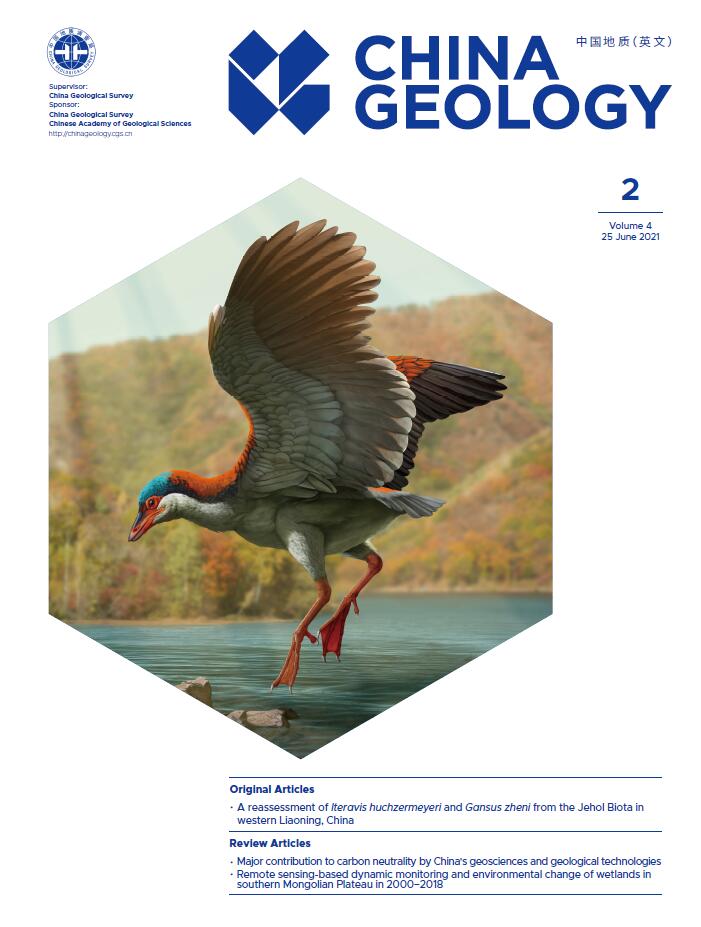

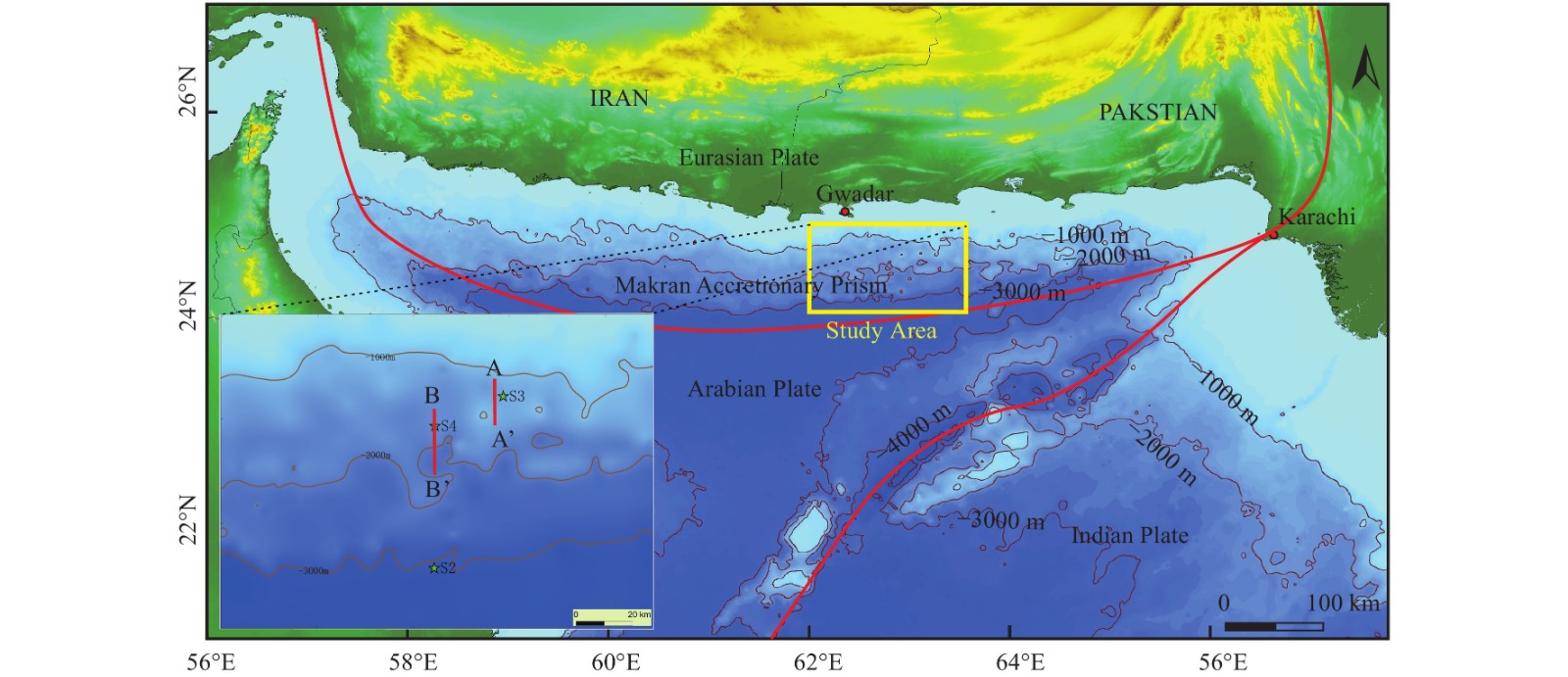

 DownLoad:
DownLoad:






